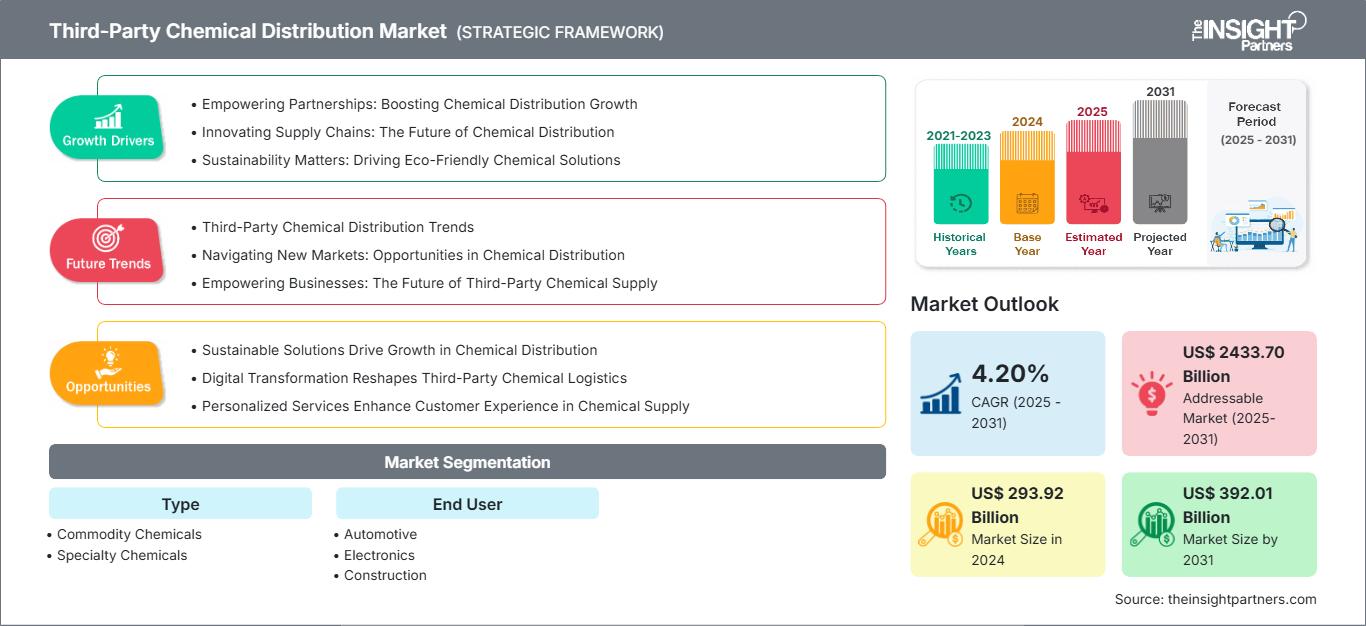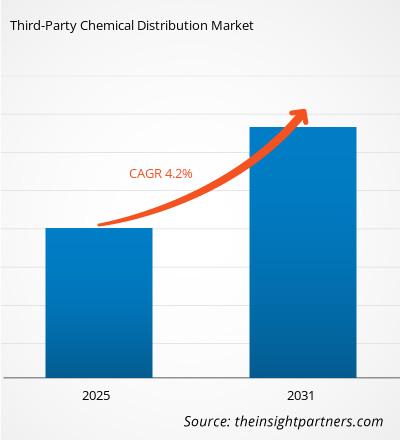Si prevede che il mercato della distribuzione di prodotti chimici di terze parti registrerà un CAGR del 4,20% dal 2025 al 2031, con una dimensione del mercato in espansione da 293,92 miliardi di dollari nel 2024 a 392,01 miliardi di dollari entro il 2031.
Il rapporto è suddiviso per tipologia (prodotti chimici di base, prodotti chimici speciali) e analizza ulteriormente il mercato in base all'utente finale (settore automobilistico, elettronico, edile, petrolifero e del gas, farmaceutico). Per ciascuno di questi segmenti chiave viene fornita una ripartizione completa a livello globale, regionale e nazionale.
Il rapporto include dimensioni e previsioni di mercato per tutti i segmenti, con valori espressi in dollari statunitensi. Fornisce inoltre statistiche chiave sullo stato attuale del mercato dei principali attori, oltre ad approfondimenti sulle tendenze di mercato prevalenti e sulle opportunità emergenti.
Scopo del rapporto
Il rapporto Third-Party Chemical Distribution Market di The Insight Partners mira a descrivere il panorama attuale e la crescita futura, i principali fattori trainanti, le sfide e le opportunità. Ciò fornirà spunti di riflessione a diversi stakeholder aziendali, tra cui:
- Fornitori/produttori di tecnologia: per comprendere le dinamiche di mercato in evoluzione e conoscere le potenziali opportunità di crescita, consentendo loro di prendere decisioni strategiche informate.
- Investitori: per condurre un'analisi completa delle tendenze in merito al tasso di crescita del mercato, alle proiezioni finanziarie del mercato e alle opportunità esistenti lungo la catena del valore.
- Enti di regolamentazione: regolamentano le politiche e le attività di controllo sul mercato con l'obiettivo di ridurre al minimo gli abusi, preservare la fiducia degli investitori e sostenere l'integrità e la stabilità del mercato.
Segmentazione del mercato della distribuzione chimica di terze parti
Tipo
- Prodotti chimici di base
- Prodotti chimici speciali
Utente finale
- Automobilistico
- Elettronica
- Costruzione
- Petrolio e gas
- Prodotti farmaceutici
Riceverai la personalizzazione gratuita di qualsiasi report, incluse parti di questo report, analisi a livello nazionale, pacchetto dati Excel e potrai usufruire di fantastiche offerte e sconti per start-up e università.
Mercato della distribuzione chimica di terze parti: approfondimenti strategici

-
Scopri le principali tendenze di mercato di questo rapporto.Questo campione GRATUITO includerà analisi dei dati, che spaziano dalle tendenze di mercato alle stime e alle previsioni.
Fattori trainanti della crescita del mercato della distribuzione di prodotti chimici di terze parti
- Rafforzare le partnership: stimolare la crescita della distribuzione chimica
- Innovazione nelle catene di fornitura: il futuro della distribuzione chimica
- La sostenibilità è importante: promuovere soluzioni chimiche ecocompatibili
Tendenze future del mercato della distribuzione chimica di terze parti
- Tendenze nella distribuzione di prodotti chimici di terze parti
- Esplorare nuovi mercati: opportunità nella distribuzione chimica
- Potenziare le aziende: il futuro della fornitura di prodotti chimici di terze parti
Opportunità di mercato nella distribuzione di prodotti chimici di terze parti
- Le soluzioni sostenibili guidano la crescita nella distribuzione chimica
- La trasformazione digitale rimodella la logistica chimica di terze parti
- I servizi personalizzati migliorano l'esperienza del cliente nella fornitura di prodotti chimici
Approfondimenti regionali sul mercato della distribuzione chimica di terze parti
Le tendenze regionali e i fattori che influenzano il mercato della distribuzione di prodotti chimici per conto terzi durante il periodo di previsione sono stati ampiamente spiegati dagli analisti di The Insight Partners. Questa sezione illustra anche i segmenti e la geografia del mercato della distribuzione di prodotti chimici per conto terzi in Nord America, Europa, Asia-Pacifico, Medio Oriente e Africa, America Meridionale e Centrale.
Ambito del rapporto sul mercato della distribuzione di prodotti chimici di terze parti
| Attributo del report | Dettagli |
|---|---|
| Dimensioni del mercato nel 2024 | 293,92 miliardi di dollari USA |
| Dimensioni del mercato entro il 2031 | 392,01 miliardi di dollari USA |
| CAGR globale (2025 - 2031) | 4,20% |
| Dati storici | 2021-2023 |
| Periodo di previsione | 2025-2031 |
| Segmenti coperti |
Per tipo
|
| Regioni e paesi coperti |
America del Nord
|
| Leader di mercato e profili aziendali chiave |
|
Densità degli operatori del mercato della distribuzione chimica di terze parti: comprendere il suo impatto sulle dinamiche aziendali
Il mercato della distribuzione di prodotti chimici per conto terzi è in rapida crescita, trainato dalla crescente domanda degli utenti finali, dovuta a fattori quali l'evoluzione delle preferenze dei consumatori, i progressi tecnologici e una maggiore consapevolezza dei benefici dei prodotti. Con l'aumento della domanda, le aziende stanno ampliando la propria offerta, innovando per soddisfare le esigenze dei consumatori e sfruttando le tendenze emergenti, alimentando ulteriormente la crescita del mercato.

- Ottieni una panoramica dei principali attori del mercato della distribuzione chimica di terze parti
Punti di forza chiave
- Copertura completa: il rapporto copre in modo completo l'analisi di prodotti, servizi, tipologie e utenti finali del mercato della distribuzione di prodotti chimici di terze parti, fornendo un panorama olistico.
- Analisi degli esperti: il rapporto è redatto sulla base della conoscenza approfondita di esperti e analisti del settore.
- Informazioni aggiornate: il rapporto garantisce la pertinenza aziendale grazie alla copertura delle informazioni più recenti e delle tendenze dei dati.
- Opzioni di personalizzazione: questo report può essere personalizzato per soddisfare le esigenze specifiche del cliente e adattarsi in modo appropriato alle strategie aziendali.
Il rapporto di ricerca sul mercato della distribuzione di prodotti chimici di terze parti può quindi contribuire a tracciare un percorso di decodificazione e comprensione dello scenario e delle prospettive di crescita del settore. Sebbene possano esserci alcune valide preoccupazioni, i vantaggi complessivi di questo rapporto tendono a superare gli svantaggi.
- Analisi storica (2 anni), anno base, previsione (7 anni) con CAGR
- Analisi PEST e SWOT
- Valore/volume delle dimensioni del mercato - Globale, Regionale, Nazionale
- Industria e panorama competitivo
- Set di dati Excel
Report recenti
Testimonianze
Motivo dell'acquisto
- Processo decisionale informato
- Comprensione delle dinamiche di mercato
- Analisi competitiva
- Analisi dei clienti
- Previsioni di mercato
- Mitigazione del rischio
- Pianificazione strategica
- Giustificazione degli investimenti
- Identificazione dei mercati emergenti
- Miglioramento delle strategie di marketing
- Aumento dell'efficienza operativa
- Allineamento alle tendenze normative






















 Ottieni un campione gratuito per - Mercato della distribuzione chimica di terze parti
Ottieni un campione gratuito per - Mercato della distribuzione chimica di terze parti